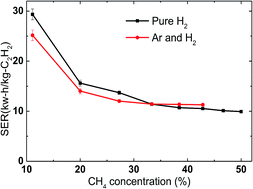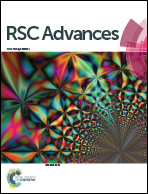Efficient methane-to-acetylene conversion using low-current arcs
Abstract
The proliferation of natural gas production had led to increased utilization of methane as a raw material for chemicals. The most significant bottleneck in this process is the high activation energy of methane. This paper reports the direct conversion of methane to acetylene in a novel rotating arc driven by AC electrical power. By feeding a sufficiently high concentration of CH4 (greater than 43%) diluted in H2 (the discharge gas) through the arc column, a low specific energy requirement (SER) of 10.2 kW h kg−1 C2H2 was achieved. The use of hydrogen as the discharge gas strongly suppressed soot formation during the methane conversion process under high methane concentration conditions, resulting in a carbon balance of greater than 95% and a C2H2 selectivity of greater than 90% while maintaining a methane conversion rate of greater than 70%, depending on the conditions. The novel rotating arc enabled the elongation of the arc column itself, which controlled heat loss and improved the energy use for reaction. The ability to control the arc length based on low-current type arc generation has additional benefits for reaction enhancement. These results demonstrate that arc control, optimization of the reaction conditions, and a full understanding of reaction pathway are viable means for the energy-efficient direct conversion of methane to acetylene.



 Please wait while we load your content...
Please wait while we load your content...